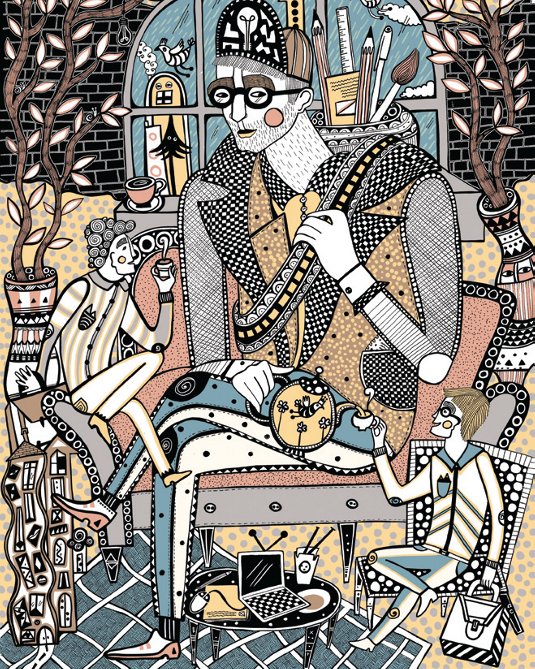The secrets of great client relationships
Client management might sound dull, but it'll lead to better paid and more interesting work.
When running a design business, it is impossible to underestimate the importance of client relationships. From freelance creatives whose clients are other industry firms, to agencies blessed with rostered regulars – looking after your fee payers should be priority number one.
According to the great Paul Rand, design is futile "unless it is acknowledged by those that the designer exists to serve – the clients". At its most basic level, a good client relationship means trust, communication and accountability. Client relationships should be a mutually beneficial partnership between you and your client.
Your expertise and critical opinion should be valued, while your clients should feel they can trust you in creating the most suitable work for their products. Getting to this stage takes time, hard work and investment in a client relationship strategy, but it is easily achievable for creative outfits of all sizes.

Client relationships can be an uneven see-saw: you can produce the best work possible, on time and to budget and still lose a client, while you can watch others produce mediocre work and enjoy repeat business. It's unfair, annoying and disruptive. But it is avoidable.
Investing in client relationships leads to repeat work, more money and strengthens word-of-mouth promotion. Strong relationships enable the creation of more satisfying, worthwhile projects, which is what all designers strive for and, appropriately, the best way to increase visibility and win new work. In short, strong client relationship skills are where it begins for growing your creative reputation, generating more turnover, and ultimately creating even more fulfilling work.
The figures paint an even more convincing argument: according to BDI (British Design Innovation), for every client lost, UK design businesses have to spend around 20 per cent of a project fee on new business activity through promotional means and cold pitching. For repeat work, that figure is zero per cent.
Understanding people
"Every client is worth holding on to. Winning clients is difficult in itself, so holding onto them is absolutely critical," says Katy Cowan, managing director at Boomerang, the creative agency with a roster that includes retailers, manufacturers and healthcare accounts.
Get the Creative Bloq Newsletter
Daily design news, reviews, how-tos and more, as picked by the editors.
"Essentially, business is about people," she continues. "So it's about understanding how to work with people, maintain healthy relationships and be someone that people enjoy working with. Of course, it's also about offering value – ensuring the work you are doing is making a real difference to your client."
Winning new clients and establishing a solid working relationship with them takes time and effort, and is traditionally looked after by an account handler or client director. Yet it's vital that all relevant staff are aware of the client and contribute towards the relationship – from creative directors to artworkers.
"It's critical that everyone involved in an account knows who the client is, who the contact is, and what the client likes and doesn't like," says Mark Haynes, a new business consultant who was previously client services manager at marketing services company Chime UK. "At Chime, we worked exceptionally hard to get under the skin of our clients' brands, and offer the type of service that fosters trust. You cannot allow even one person to stray off-brief and damage that trust."
For agencies and studios like Boomerang and Chime, a client retention plan is critical. This can take the form of a top-sheet of essential client information, for example: contact points for different areas of the account. A more fully-fleshed client retention plan might include a history of the client and the work you've completed for them, as well as a creative overview of the brand and information on any strategic objectives that the client has highlighted.
"Being able to pick up the phone and speak to the right person is vital," explains Haynes. "There might be an entirely different person in a different office who has sign-off on artwork, while budgets and strategy are handled elsewhere. You need to keep your communication channels open and make sure you speak to the right people about the right things."
It's also advisable to identify some sort of hierarchy and make sure everyone in your business is aware of it. Ideally you need to ensure that, should one of your contact points be unavailable, you know who's next in line to consult. What's more, by identifying a hierarchy within your client's business, you are more likely to be able to cut out 'middle-men' and engage directly with the decision makers - whether that be a creative head, or a strategic or financial manager.

Keeping clients
Retention plans also generate new business organically. If an initial client brief begins as a rebrand, it can quickly escalate to a full 360-degree project if you prove yourself in the initial stages.
"Most of our clients are retained," says Cowan. "The nature of our work relies upon ongoing support, as we provide an iterative service. For instance, we might build a website or app, carry out ongoing user testing and then add new features along the way."
Client relationship management isn't about 'schmoozing', as Cowan points out. In fact, very few of those we spoke with gave the impression of Mad Men-style long lunches and big nights out on expenses. Successful client relationships are about communicating and delivering on your promises: basic project management skills.
"We have regular meetings and we plan what we're going to do each and every month," says Cowan. "Internally, we use systems like Basecamp to project manage and we'll track time involved using FreeAgent. For some of our clients, we might use software to ensure smooth running – for example, for our social media marketing we use apps like SproutSocial."
But don't be tricked into thinking client relationship management is just for agencies and design studios, however. Freelancers too need to treat their clients with care, as the freelance illustrator Steven Bonner points out.
"Freelancing is just being a small business-owner so the principles of relationship management are the same," he says. "For me there's no magic to it: you simply treat people well and do what you say you'll do for them. If you deliver on your promises, are accommodating to reasonable requests and can do it all with a smile on your face, then you'll be fine."
Bonner is a typographer, illustrator and designer who was won numerous international awards. For him, building and maintaining a relationship is about being professional, and being personable.
"You've got to work hard to build relationships, then harder again to make them strong," he says. "It's a small industry where everyone knows each other, so building a good relationship with someone can be a great way of networking and getting a foothold in new companies."
Healthy relationships
However, it's important to remember that there has to be some give and take. Unhealthy relationships can come about, for instance, if a client never listens to your advice. If that's the case, it might be worth moving on. It's obvious when you find a client with whom you work well, but it's also important to spot bad clients early on.
"Clients worth holding onto are those who brief and art direct really well," Bonner says. "Vague briefing and non-existent direction are the bane of a freelancer's life, as they eat into budgets, time and quite frankly, your patience. The good client is the one who understands how to work with you."
Managing your client list doesn't just mean picking and choosing who to work with, though. As well as identifying those clients with whom it's possible to have a broader creative relationship, it's also smart to avoid stage managing too much.
"It's not something we budget for necessarily, but we do often entertain clients," says Cowan. "It's nice to pop out for a coffee or lunch and offer to pay. I've just had an informal lunch with one of my biggest clients, and it was nice to chat over some sandwiches. Like I said before, business is about people, so offering that bit of give and take always helps to strengthen relationships."
Above all else, client relationship management is about treating other people with respect. When your client asks you for a project update; shifts a deadline or drags its feet on a decision, professionalism means you don't get fiery. In fact, according to Bonner, the best relationship technique requires general good manners, and taking an interest in the person as well as the project.
"Clients are people too," sums up Bonner. "And people like to deal with people that they can relate to. I'm not saying you need to be their best friend, but it's nice to be able to have a friendly conversation about other things too."
Words: Tom Dennis
This article originally appeared in Computer Arts issue 220.
Liked this? Read these!
- Illustrator tutorials: amazing ideas to try today!
- Create a perfect mood board with these pro tips
- The ultimate guide to logo design

Thank you for reading 5 articles this month* Join now for unlimited access
Enjoy your first month for just £1 / $1 / €1
*Read 5 free articles per month without a subscription

Join now for unlimited access
Try first month for just £1 / $1 / €1

Tom Dennis is a journalist, editor and content director with more than a decade’s experience working on international magazines, newspapers, and websites. While Tom is an expert on all things tech, having previously edited sister Future sites T3 and Computer Arts and picked up a PPA award for being a 'Digital Native', he still has a soft spot for the printed word. Tom has since moved into digital content marketing.
